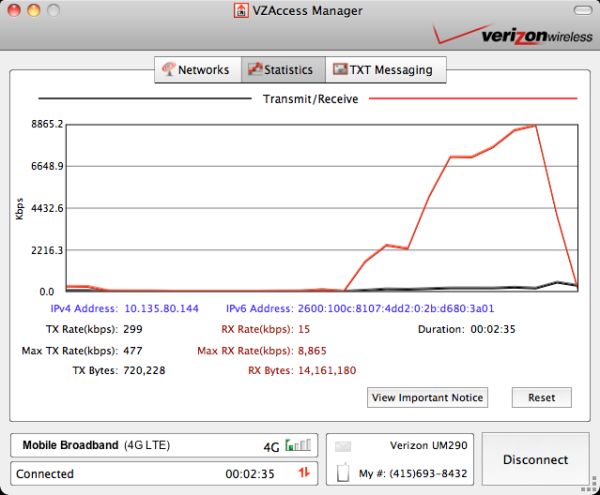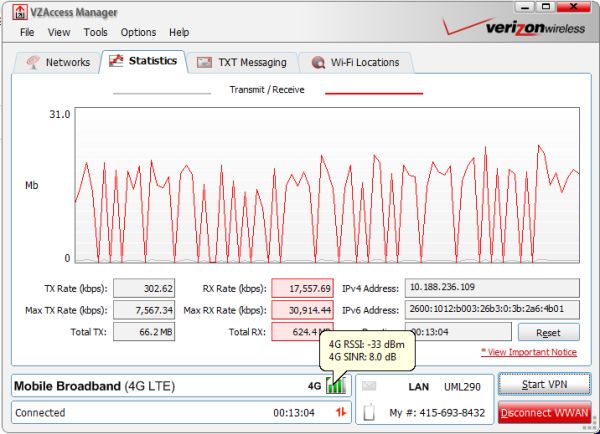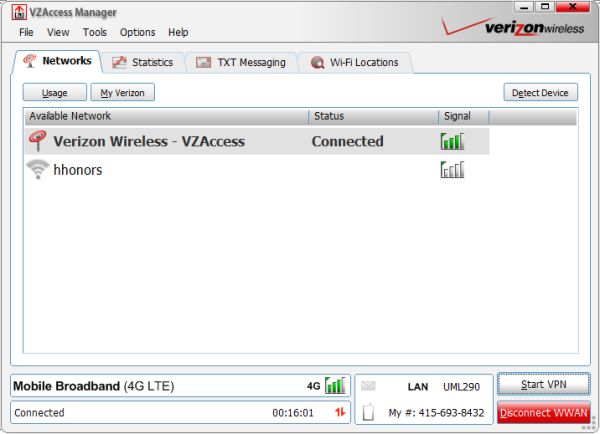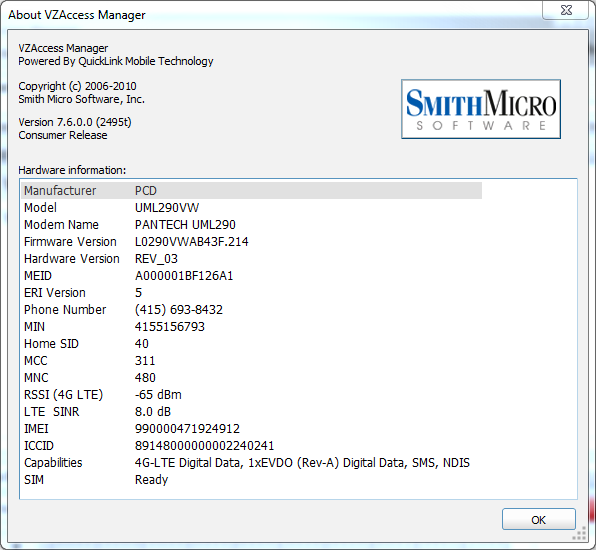Verizon 4G LTE: Two Datacards and a WiFi Hotspot Massively Reviewed
by Brian Klug on April 27, 2011 12:11 AM EST- Posted in
- Smartphones
- Samsung
- Verizon
- LTE
- 4G
- Pantech UML290
- USB551L
- Mobile
- MDM9600
Data Card Software: VZAccess Manager
The other part of the picture is software. Both modems use Verizon’s VZAccess Manager program on OS X and Windows. I guess that brings me to my primary complaint about both of these data cards—they don’t have internal storage partitions with the software stored on them.
In the past, data cards I’ve used seem to always have at very least a read only partition, sometimes even a microSD card drive letter, where drivers and management software were stored. The obvious reason for this was that you could then have a guaranteed way of getting online even if you didn’t have the driver CD with you. Without this, you can potentially be stuck in a maddening Catch-22 situation where you could conceivably get online, but only if you had the foresight to install drivers beforehand. I literally have a small pile of various modems for EVDO and UMTS that all have this simple feature.
So for some reason, all of Verizon’s launch 4G LTE modems lack an internal storage partition with the drivers, which is incredibly confusing. I sincerely hope newer modems have the feature, and that the reason this is lacking is purely due to the current architecture of these cards and not some legal preclusion.
I started using the UML290 before its first firmware update, and likewise before it had official OS X support. The UML290 needed a firmware flash from the Windows version of the VZAccess Manager; then I could download the OS X version of VZAccess Manager and use the UML290 without issue.
My initial testing results from the UML290 were taken on a Latitude XT running Windows 7, and later on an Inspiron 8500. However, I spent equal amounts of time just testing the two on a 2010 MacBook Pro and 2011 MacBook Pro.
 VZAccess Manager on OS X 10.6.7
VZAccess Manager on OS X 10.6.7
In Windows, VZAccess manager has a bit more configuration detail and offers different options than on OS X, but overall the organization and functionality is the same. There are tabs for both connectivity management, statistics, SMS/text messaging, and finally WiFi locations. At the bottom is a persistent bar displaying connectivity status, duration, activity, current cellular number (the data card still has a phone number for SMS), and signal strength. Hovering over the signal strength bars creates a bubble with more details about the current cell environment. When connected to 1x or EVDO, you get the current RSSI (Received Signal Strength Indication) for both 1x and EVDO. When connected to 4G LTE, you get both RSSI and SINR (Signal to Interference Noise Ratio).
I’m glad to see that SINR is being reported, since it’s very important on LTE to have a measure of how much noise there is in addition to inter-symbol-interference due to loss of orthogonality. This can come from reflections that exceed the cyclic prefix length, and more importantly from doppler shift, which causes loss of carrier orthogonality when the user equipment is moving quickly. Thankfully OFDM is engineered to work with this.
In LTE SINR is probably the most important quality metric; however, I feel like SINR is being reported incorrectly in the VZAccess Manager. Based on the definition of SINR and the data I collected, it seems that there’s either a missing negative sign, they report the inverse, or something else is wrong. Higher SINR is better and should result in better throughput.
VZAccess Manager by default pulls in your current usage statistics over SMS when you first connect. This is somewhat of a problem because it can force you to drop back to EVDO while the SMS is received. I disabled this in the client and never experienced any problems. On Windows, you can also send AT commands by hitting control-T, which is pretty much what you have to do to reconfigure proper APNs if you used the UML290 on OS X before the official firmware flash and update went out.
Inside the speeds tab is a graph of upstream and downstream throughput. There are fields for average and maximum over the sampling window down below, and running totals for the current data session. To the right are the local IPv4 address and IPv6 address. Back before an update, the graph for speeds used to have some strange sampling that would show a very odd throughput profile with periodic dips. This is fixed in the newer version and is much smoother, reflecting the actual throughput profile.
One thing that’s a bit frustrating is that inserting a new card requires you to click detect before the card can be connected. This can take a while sometimes unless you always use the same datacard. I’ve put together a full gallery with screenshots from the Windows and OS X versions of the access manager suite. There’s a majority of stuff which is virtually identical between the two versions.

Probably the most frustrating thing right now however is that there’s a disparity in what software versions the cards use on OS X. As of this writing, all the cards use 7.6.3 on Windows. However, on OS X, the USB551L uses 7.2.3 instead of the newer and more stable 7.2.5 that the older VL600 and UML290 datacards use. As a result, the newer USB551L (which is the only one with OS X support noted on the box) actually has worse OS X support than the two older cards that gained it from a firmware flash.
Further, I experienced a substantial number of kernel panics while using the USB551L on both a 2010 and 2011 MacBook Pro. Both computers had no kernel panics running 7.2.5 and the UML290. I experienced no instability or dropped connections with either card on Windows XP or 7. In that scenario, everything is perfectly stable. I have no doubt that all of these problems with the USB551L will be worked out with firmware updates and another software release that will bring everything up to version parity, but right now the situation is frustrating on OS X.
The Pantech UML290 as of this writing is going for $49.99 on a two year contract ordered online, or $249.99 without. The Novatel USB551L is selling for $99.99 on a two year contract ordered online, or $249.99 without. It’s odd to me that the UML290 is being discounted to $50 cheaper than the USB551L and VL600, especially considering that the UML290 in my opinion has vastly better build quality and current OS X support. It’s entirely possible however that it isn’t selling as well due to its rather large flip-out design.



















32 Comments
View All Comments
OctavioShaffer - Tuesday, November 13, 2018 - link
this very informative, i can now open my vpn server, through my Ip address 192.168.1.1. because recently i spend days just to search a to fix my problem. Thanks alot!strikeback03 - Wednesday, April 27, 2011 - link
I live in an LTE market and would be happy to accept some LTE devices if you don't want to be driving to Phoenix ;)For that matter I also have a Droid X with the stock 2.2 build.
Playing with a Thunderbolt at a Verizon store the data speeds are really quick. Will be interesting to see how much they drop off though with more users.
Penti - Wednesday, April 27, 2011 - link
They use 20MHz in 2.6GHz here in Sweden (few cities so far) so you can actually see speeds up to about 80 Mbits here, LTE-Adv on 800MHz is in the works of being deployed here now, but they will be using 10MHz spectrum. I'm guessing people in major cities will see 20-80Mbits and people in areas only covered by 800MHz will see 10-40Mbits. Latency is where it clearly matters though. Though 50 Mbits on 2x10MHz 700MHz is clearly at the top. It's not often you will see much of high speeds any way.To bad they pretty much price themselves out of the market though. A 16Mbit Turbo3G connection is less then half of what 4G costs here. For limitless traffic at least.
xp3nd4bl3 - Wednesday, April 27, 2011 - link
Love the graphing.mars2k - Wednesday, April 27, 2011 - link
Not good, I need USB tethering. This is a deal breaker for me. I need outside access in several places where wi fi is not allowed.Lord 666 - Wednesday, April 27, 2011 - link
Brian,Currently have an open ticket with VZW about the lack of public addresses. Have several LTE cards used with cradlepoints that are used for DMVPN backup connections and need public addresses. In testing, would randomly get nat'd address bring up a complete tunnel, but it was very rare. All of the IPs issued were 10.xxx in NYC.
Was told static public IPs will be available around May.
nerdydesi - Wednesday, April 27, 2011 - link
I'm curious on what you meant by this."Note that the Thunderbolt is a 2x1 device while the others are 2x2, which explains some of the upstream throughput distribution difference"
Do you mean that the other devices have more antennas than the Thunderbolt and thus why their speeds seemed to be faster than the Thunderbolt? Regarding the phone and its "unlimited data", I used 30gb in my last billing cycle and so far 70gb now with no peep from Verizon. It could also be that I'm currently a VZW employee. I hope that because I bought the phone, I can be grandfathered into the plan.
Also as a note, if you take the sim card from the Thunderbolt with its full voice and data plan and put that into a mifi or USB modem, you get the unlimited data as well. Just keep in mind you pay more per month due to having the voice along with it (which is useless on the modem devices), but still better than the current 5gb and 10gb caps. If you do vice versa, take the card from a modem to an LTE phone, you are charged for each minute of voice and each text unless you change your plan.
DanNeely - Wednesday, April 27, 2011 - link
" AT&T on the other hand has a sprinkling of lower block B and C licenses that are both 12MHz. AT&T also purchased Qualcomm's licenses to blocks D and E, which are both 6MHz unpaired, though it's not entirely clear how AT&T will integrate both blocks of unpaired spectrum. All total that gives AT&T between 24 and 36MHz of 700MHz spectrum, again depending on market."Since the only blocks that they own nationwide are the 6mhz D and E blocks shouldn't it be 12 to 36mhz of spectrum. Looking at auction maps it appears there're fairly large areas where ATT didn't win the A or the B blocks.
http://www.cellularmaps.com/700_auction.shtml
Brian Klug - Thursday, April 28, 2011 - link
That's a good point. If they can manage to either TDD or FDD both of those it should be 12 to 36. Just don't forget about the lower C block which was involved prior to this latest auction, that's the 24 that I'm thinking of.With 12 MHz of spectrum they can run 5 MHz FDD channels which really won't be much faster than current WCDMA systems. I guess that's why I mentally discounted it.
-Brian
Lothsahn - Wednesday, April 27, 2011 - link
I notice that with my Sprint aircard, I maintain the 3G connection even during extended trips across the nation. However, the 4G connection on the same aircard appears to be unable to handoff and loses its connection while traveling constantly. I find that my connection disconnects every 2-3 minutes when actually moving. However, if I'm stationary in a building, it'll maintain the connection for hours.What results did you have with LTE for these sorts of usage scenarios?